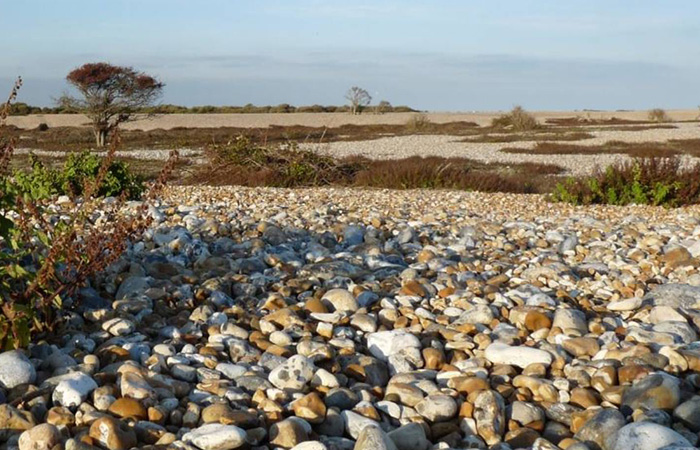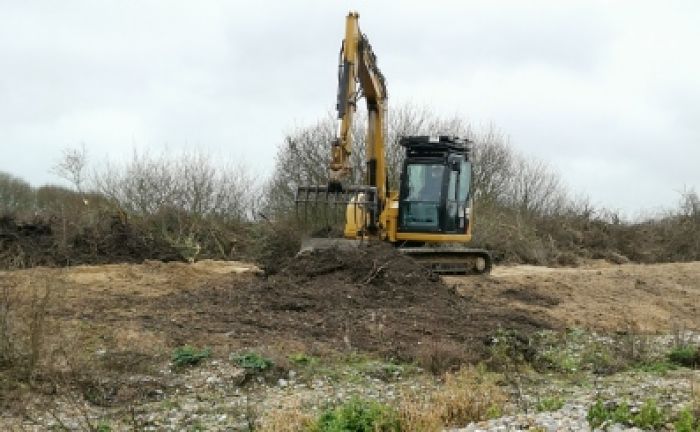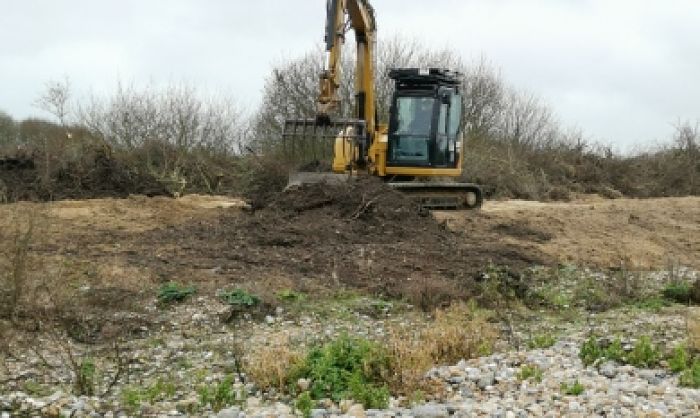Shingle on the Cusp

Vegetated shingle is an incredible habitat which tells the story of how nature battles the elements to create fantastic diversity in the harshest of settings. From yellow horned poppies to Sussex emerald moths, it is home to a range of highly specialised and in many cases extremely rare plants and animals some of which are found on Dungeness and nowhere else in the world!
Listed below are the key achievements with this project. Please click on the green bars to reveal information on what has been achieved to date.
Key achievements to date include the successful installation of the brash pile trials in the RSPB Dungeness and MoD Lydd Ranges sites – we are trying to see if using brash in this way helps promote establishment of specialist shingle plants on areas of bare shingle. The experimental plots have been surveyed over the last few years and the indications are that brash does help plants to get established more quickly. We have yet to complete the analysis of the data but our current thinking is along two lines – firstly that the piles act as windbreaks which catch seeds on the wind, making them fall to the shingle where they are able to germinate and secondly that the brash has a shading effect which allows more moisture to remain in the shingle for longer into summer which helps the plants to grow.

We have also been working hard with the RSPB over the last couple of years, to control various invasive plant species which threaten the unique flora and fauna of the Dungeness reserve. The key ones we have targeted were Red Valerian (Centranthus rubra) in 2019/20 which was hand-pulled by volunteers as well as being cut – this produces lots of windblown seeds and has a tendency to dominate other plant species. In spring of 2021 we got to work on 4 hectares of Sea Buckthorn (Hippophae Rhamnoides) which had become the only plant and was growing in dense thickets on sand and gravel – clearing this will allow the important community of mosses, lichens and other low ground flora to re-establish.
The project has also produced a leaflet – Gardening by the sea. This leaflet provides some handy hints on how to get the best out of your garden whilst helping nature to thrive in coastal environments and was sent out to all houses in the Greatstone and Littlestone areas in 2019. We hope that this has encouraged householders to consider what species they plant in their gardens and which plants to avoid as they could become invasive.

2021
MAJOR WORK TO REMOVE SEA BUCKTHORN
Major work with a large digger to remove 3.5 hectares of Sea Buckthorn (Hippophae rhamnoides) a native plant that has become increasingly invasive has started in the RSPB Dungeness reserve. It forms very dense thickets so nothing else will grow underneath it, spreads through underground runners, has 3cm long spines and produces masses of fruit and seeds – a real thug
2020
SECOND VEGETATION SURVEY COMPLETED ON BRASH PILES
Second vegetation survey completed on the brash piles – the data collected will be used to analyse the impacts of differing heights of brash on the rate and species diversity of plants colonising the bare shingle
INVERTEBRATE SURVEY 2020 COMPLETED
Invertebrate survey for 2020 completed by Tony Witts on the brash piles which were installed on the RSPB Dungeness reserve to look at whether laying brash on top of bare shingle speeds up colonisation by plants and mosses and the impact on insect diversity and abundance. This second survey of the invertebrates will be completed in 2021 as Covid-19 caused disruption last year.
Control of invasive species completed
Targeted removal of invasive plants on the RSPB reserve focusing on the worst affected areas has been completed with the removal of red valerian. Some additional hand puling will be undertaken in the summer this year to finally remove any remaining. Completion of the work will allow the recolonisation by native species.
2019
New school shingle garden
Visit to Lydd Primary school. With the help of students from year 5 we planted a new shingle garden within the school grounds using all local species.
Gardening by the sea leaflet posted out
The Gardening by the Sea leaflet has been posted out to every household along the coast in the Little Stone and Great Stone areas. We will review the shingle website page to assess level of traffic following the focused circulation of the leaflet.
Control of invasive species started
Targeted removal of invasive plans has commenced on the RSPB reserve focusing on the worst affected areas to allow recolonization by native species.
Gardening by the sea leaflet published
What you plant in your garden can have a lasting effect on the landscape around you. The Gardening by the Sea leaflet provides some handy hints on how to get the best out of your garden whilst helping nature to thrive. To view the leaflet, follow the link in our March 6th item on the Blog page . The leaflet will be distributed widely across the area.
The Shingle Resource published
We are preparing resources for residents and people visiting the area. Our first ‘The Shingle Resource’ was published on 5 February 2019. This is a one stop shop for all you’ll ever want to know about living with or visiting shingle and dune habitats for locals and for visitors. The resource provides practical advice on issues affecting your area. You can access the resources library by clicking the new ‘Resources’ button on most pages of this website.
2018
Shingle information pages in development for website
New shingle website information pages are currently under development. The new pages will be a source of information for visitors and residents living in Dungeness and the surrounding areas. The new pages are likely to go live in February 2019.
Survey of shingle species completed
After a whole summer and autumn of surveying, 164 invertebrate species have been recorded including: one entirely new species for Kent Anotylus clypeonitens which is an absolutely tiny beetle; a rare species of dung beetle that was thought extinct until a couple of years ago called Rhyssemus Germans; and a very rare spider which is a Dungeness speciality called Pellenes tripunctatus (See photo above taken by Tony Witts). This data, as well as being important in its own right, will also serve as a baseline against which we can measure the effect of the brash piles over time.
Survey of shingle species – update
Preliminary data gathered looks promising. Raw data will not be processed until we have completed the data gathering for this year.
Information leaflet
Leaflet content on shingle plants and controlling invasive species is currently going through a design review process.
Survey of shingle species commenced
Consent granted by Natural England & RSPB for invertebrate surveys to be undertaken at Dungeness, starting on 22 May. This will involve putting in 30 pitfall traps which will capture ground dwelling insects. Baseline surveys will be ongoing throughout the summer, with the traps being visited fortnightly.
Information leaflet
Putting together a leaflet on shingle plants and controlling invasive species.
Trial vegetation restoration plots
Trial vegetation restoration plots are all out at Lydd to match the ones at RSPB Dungeness. Many thanks to the MoD for taking part in our unusual experiment, and huge thanks to the volunteers!
Installing the experimental plots at RSPB Dungeness
We recently had our first day out installing the experimental plots at RSPB Dungeness. Check out the Blog! We are talking with the Ministry of Defence about when we can also do this at Lydd Ranges (they have agreed in principle). We are currently designing a leaflet to go out to all Dungeness residents about the importance of the shingle habitat and the need to control invasive species.
Visit our News Archive page.
The Shingle Resource
This is a one stop shop for all you’ll ever want to know about living with or visiting shingle and dune habitats for locals and for visitors. The resource provides practical advice on issues affecting your area. Click here for more information.
Gardening by the sea
What you plant in your garden can have a lasting effect on the landscape around you. The Gardening by the sea leaflet provides some handy hints on how to get the best out of your garden whilst helping nature to thrive. Follow the Gardening by the sea link to view the leaflet.
Shingle on the Cusp project contributes to the Restore project theme.
<< back to Project list









